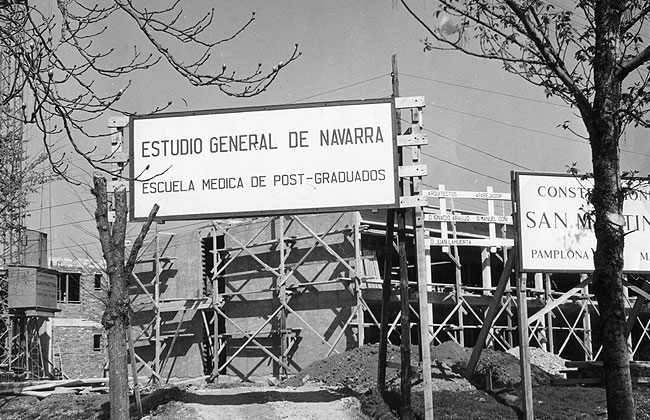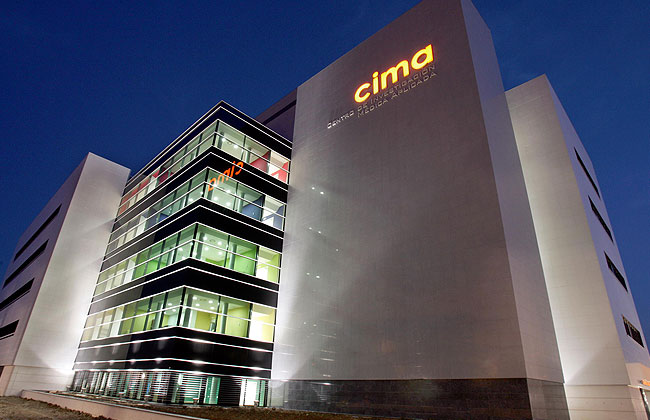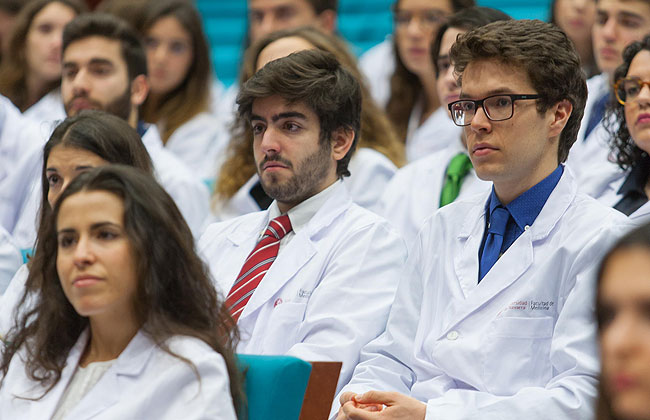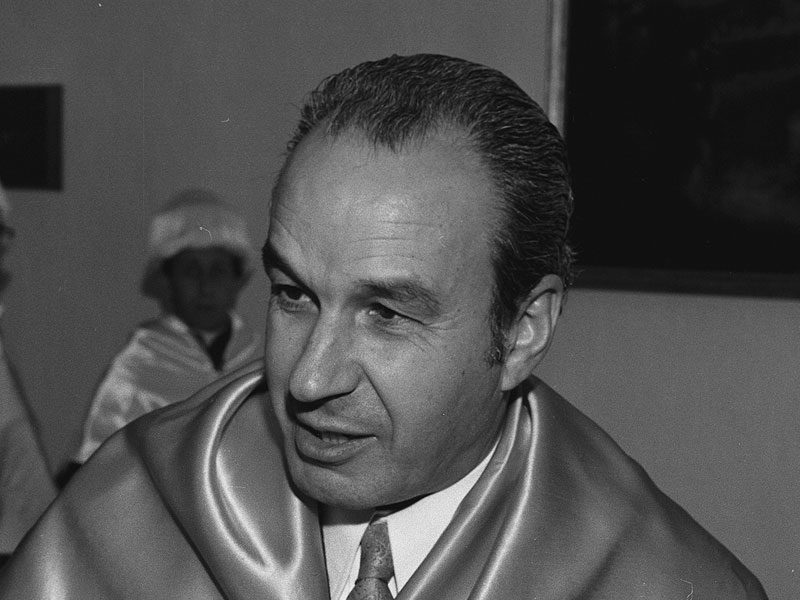
years beating for life
1954-2024
October 8, 1954 was a singular day for the School: the first class of Medicine was given at the University of Navarra and a singular way of teaching and practicing this profession began.
This concept of the physician at the service of life, patients and their families, of which we are especially proud, is more necessary today than ever. In the words of Bishop Fernando Ocáriz, Chancellor of the University: "So many souls have benefited in their health and living conditions as a result of the medical and human knowledge imparted in these classrooms. I also think of so many who have preceded you and have made possible, with their generous submission and their work, this reality from which many students will continue to benefit. It is always worthwhile to put our lives at the disposal of others".
This year we want to commemorate seven decades of academic excellence, innovation in medical research and commitment to service to society.
A brief look at our history
-
1954
The School of Medicine is born
The classes of the newly born School of Medicine, today School, began on October 8, 1954. During that first course they were held in the Chamber of Deputies. There were 25 students enrolled.
The first course had a preparatory character, focused on physico-chemical and biological subjects, so that the students could have a solid preparation when facing the strictly medical subjects.
-
1955-1956
"Old School".
Soon, the facilities in Comptos, which were shared with the Law School School , became too small. In the 55-56 academic year, the Medicine classes were moved to the so-called "Old School", a building inside the Hospital of Navarra, on loan from the Provincial Council.

-
1956
Research
Already in 1956, despite the lack of resources, an intense research activity began to develop at School, with the impulse of Dean Juan Jiménez Vargas himself and other professors such as Félix Álvarez de la Vega or Álvaro del Amo.

-
1958
Clinical subjects
The beginning of the academic year 57/58 meant a new challenge for the School and its Dean. The 4th year students began to take clinical subjects and it became necessary to hire new teachers and to have the possibility of visiting patients.
Thus, in 1958, Dr. Eduardo Ortiz de Landázuri arrived in Pamplona from Granada as professor of Pathology and Clinical Medicine. In 1962 he was appointed Dean of the School, until 1966. He returned to position between 1969 and 1978.
-
1958
"Escuela Nueva"
In 1958 the first building of the campus in Pamplona was inaugurated, the "Escuela Nueva" (today, Research Building), and the classes of the School were moved there.
The Hospital of Navarra ceded the "Pabellón F", which was in disuse, for the teaching clinic.
-
1962
Clínica Universidad de Navarra
In 1962, the Clínica Universidad de Navarra (then Postgraduate School) began to operate, under the impulse of Dr. Martínez-Caro and Dr. Ortiz de Landázuri. The aim of goal was that medical students could specialize and that professors could continue with their work in health care.

-
1967
Carlos Jiménez Díaz, 'Honoris Causa'.
On October 7, 1967, the University, at proposal of Medicine, invested Carlos Jiménez Díaz with an honorary doctorate. This was done at degree scroll posthumously, since he had died a few months earlier. Dr. Jiménez Díaz had helped School from its origins.
That same day, President Francisco Ponz unveiled a tombstone in honor of Dr. Jiménez Díaz, located in the hall of the "Los Castaños" building. He pointed out that it had been placed at the express wish of the University's Chancellor .
-
1970
Sciences Building
At the end of the 1960s, work began on Sciences Building, known as "Hexagon Building". It was inaugurated in 1970 and since then it has housed the School of Medicine.
The 1970s saw a real demographic boom for the School: from 80 students, it suddenly grew to 220.
-
1974
Jêrome Lejeune, 'Honoris Causa'.
In 1974, St. Josemaría, as Chancellor, awarded the doctorate 'honoris causa' to Jérôme Lejeune, considered the father of modern Genetics . In 1958, Lejeune identified the trisomy of chromosome 21 that defines Down syndrome.

-
1997
agreement with the Government of Navarra
In 1997 a partnership agreement was signed between the University and the Government of Navarra for the teaching internship of the students of the School of Medicine in the Health Centers of Pamplona. This updated a agreement already signed in 1970.

-
2004
CIMA
In 2004, the research center Applied Medicine (CIMA) was inaugurated. Together with the attendance, the School has always considered the research as a point core topic both for the training of new doctors and in the academic and ordinary activity of the faculty.

-
2009
Simulation Center
work In 2009, the School inaugurated its Simulation Center which financial aid to enable students to deepen their training internship and acquire other professional competencies such as communication skills, teamwork, analysis and decision making, leadership skills, conflict resolution and stress management.

-
2015
laboratory of Medical Engineering
In 2015, the School created a pioneering laboratory Medical Engineering. Its goal is to provide practical teaching solutions and add to the close partnership that exists between the different Departments of the School, the services of the Clínica Universidad de Navarra and the laboratories of the research center Applied Medical (CIMA).

-
2020
Integrated Curriculum
In 2020, Medicine became the first Spanish School to implement, with the advice of Harvard University, the Integrated Curriculum.
This new Study program changes the way of understanding Medicine and the training of future doctors, and enables students to take the lead in their professional development and staff.
-
2022
In 2022, the School created the "Professor Jiménez Vargas" scholarships to study at Degree. The program is named after the first Dean and is aimed at students with excellent academic transcript in high school diploma and economic difficulties.

-
2022-2023
Intensive year at the Clinic
In the 2022/23 academic year, the 3rd year students have started an intensive year in which they will be trained in different specialties at Clínica Universidad de Navarra in Pamplona and Madrid. A unique rotation in Spain to apply the knowledge acquired in the first two courses.

-
Deans
Marta Ferrer, dean since 2021
Dr. Marta Ferrer is the current dean of School. Before her, they have occupied the position:
- Mr. Juan Jiménez Vargas (1954-1962)
- Mr. Eduardo Ortiz de Landázuri (1962-1966 / 1969-1978)
- Mr. Fernando Reinoso (1966-1969)
- Mr. Gonzalo Herranz (1978-1981)
- Mr. Jesús Vázquez (1981-1993)
- Mr. Pedro Gil (1993-2001)
- Mrs. Mª Pilar Civeira (2001-2010)
- Mr. Jorge Iriarte (2010-2014)
- Mr. Secundino Fernández (2014-2021)
- Ms. Marta Ferrer (2021-present)
The team of pioneers included Félix Álvarez de la Vega, Álvaro del Amo, Luis María Gonzalo, Ángela Mouriz, Gonzalo Herranz, José María Macarulla, Juan Voltas, Dolores Jurado, Diego Martínez Caro, Eduardo Ortiz de Landázuri, José Miranda, Emilio Moncada, Juan Antonio Paniagua, Javier Teijeira, Manuel Martínez Lage, Jesús Vázquez, Esteban Santiago, Fernando Reinoso and José Cañadell.
Others, later, took over at teaching, research and attendance. Such as Jesús Prieto, who arrived at School in 1979 to assist and replace Dr. Ortiz de Landázuri after his retirement. Dr. Prieto played a decisive role in the development of the research, promoting the creation of the CIMA.
* Click on the image to learn more about the pioneers of the School
Juan Jiménez Vargas
In 1954, the founder of the University, St. Josemaría Escrivá, approached Juan Jiménez Vargas about the imminent start-up of the Medical School of the Estudio General de Navarra.
uan Jiménez Vargas, Full Professor of Physiology at the University of Barcelona, was the first Dean of the School. Known as "don Juan", in his almost 50 years of activity, Dr. Jiménez Vargas developed an extensive research and trained numerous disciples.

Féliz Álvarez de la Vega
Félix Álvarez de la Vega was one of the professors on whom Jiménez Vargas relied in the early years of the School. He was Full Professor of Galenic Pharmacy at the University of Santiago de Compostela. He was in charge of the theoretical and practical classes of "Chemistry general".
In 1964 he was appointed first Dean of the School of Pharmacy.

Álvaro del Amo
Álvaro del Amo was another of the first professors at School on whom Jiménez Vargas relied. Del Amo taught the subject "Biology" coming from Coimbra.
He was the first Dean of the School of Sciences, between 1958 and 1964.

Luis María Gonzalo
In October 1955, Dr. Luis María Gonzalo joined School . Medical subjects began and he became the first professor of "Anatomy".

Angela Mouriz
In 1954, Dr. Ángela Mouriz had collaborated in the development of the School of Nursing.
In February 1956, she joined the School of Medicine to teach the "Physiology" practicals. In the academic year 57-58 she began to be in charge of "Pharmacology".

Gonzalo Herranz
Gonzalo Herranz is also rightfully part of the pioneer team of Medicine, since he joined the School in 1956. He was in Barcelona preparing his thesis when he received the call from Dean. He became position of the subject of "Histology".

José María Macarulla
The chemist José María Macarulla, who became Full Professor, began his degree program professor in the School of Medicine, at the same time that he was doing his thesis doctorate in the University of Zaragoza. He was professor of "Biochemistry ", subject which he taught together with the Italian physician Francesco Contadini.

John Voltas
Juan Voltas was a young surgeon when Don Juan Jiménez Vargas proposed him to join the School of Medicine. Dr. Voltas arrived in Pamplona in 1957, and remained at School for almost half a century, training numerous generations of physicians.

Dolores Jurado
Dolores Jurado also joined the School in 1957, just a few months after reading her thesis and marrying Dr. Voltas. She taught "Biochemistry " and "Microbiology".
She also taught class at the newly created School of Nursing.

Diego Martínez Caro
Diego Martínez Caro joined School of Medicine in 1958.
He was in charge of the start-up of what is now Clínica Universidad de Navarra.
In 1963 he was appointed Associate Dean of Medicine; and between 1966 and 1974 he was director of programs of study of the University, position new, origin of the current Vice-rectorate of Students.

Eduardo Ortiz de Landázuri
He joined School in 1958. He came from Granada as professor of "Pathology" and "Medical Clinic". He was Dean on two occasions (1962-1966 and 1969-1978).
In 1984, the University honored him for his 25 years of service; and in 1985, a few months after his death, he was awarded the Gold Medal. In 1998 his canonization process was opened.

José Miranda
In 1958, pediatrician José Miranda joined School. Under the coordination of Dr. Eduardo Ortiz de Landázuri, he worked core topic as a teacher in the first practical classes. He started up the department de Pediatría y Puericultura.

Emilio Moncada
Emilio Moncada arrived in Pamplona in 1959 under the guidance of Dr. Ortiz de Landázuri, and became position of the Polyclinic and hospital area (Pavilion F). From 1962 he was a professor and in 1968 he founded the department of Endocrinology, of which he was director until the year 2000.

Juan Antonio Paniagua
Juan Antonio Paniagua joined School of Medicine in 1959 to collaborate with Eduardo. A year later he was appointed University Secretary of the University.
At School he taught "History of Medicine" and "Deontology" for thirty years.

Javier Teijeira
Javier Teijeira joined School, from the University of Santiago de Compostela, in 1959. He was the first director of programs of study, and then Associate Dean from 1966 to 1971.
He founded the specialization program of Clinical Neurophysiology in Spain, from the Clínica Universidad de Navarra. He was the first Professor of Biostatistics at School.

Manuel Martínez Lage
Manuel Martínez Lage also joined the School in 1959. He was scholarship recipient of Professor Teijeira in the department of Electroencephalography at the University of Santiago de Compostela.
In Pamplona he changed it to specialization program of Neurology, becoming the first neurologist of the School.
He was director of programs of study between 1972 and 1975.

Jesús Vázquez
Jesús Vázquez joined the department of Histology and Anatomy Pathology at School in 1961. He specialized in the field of electron microscopy.
He was Dean of the School between 1981 and 1993 (before that he had been, for 10 years, of the School of Sciences).
He died in 1995 in a mountain accident.

Esteban Santiago
Esteban Santiago studied Medicine in Seville and Madrid, and later obtained one of the few scholarships available at that time and went to the USA. There, at the University of Wisconsin, he began to study Biochemistry , a then very new degree program , which did not exist in Spain, and which he completed in 1961.
He joined School in October 1962, encouraged by the then President José María Albareda.

Fernando Reinoso
Fernando Reinoso expanded the anatomical team at School in 1961. He was Dean between April 1966 and October 1969.
He then joined the Universidad Autónoma de Madrid, where he was appointed Vice President.

José Cañadell
In 1968, José Cañadell was appointed professor of "Orthopedic Surgery" and "Traumatology" at the School of Medicine. He was also director general of the Clínica Universidad de Navarra for 15 years (1969-1984) and its medical director for 5 more years (until 1989).

Jesus Prieto
Jesús Prieto arrived at School in 1979 to assist and replace Dr. Ortiz de Landázuri after his retirement. Dr. Prieto played a decisive role in the development of the research, promoting the creation of the CIMA.

